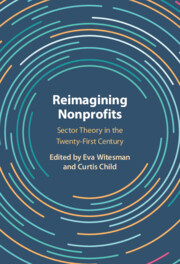Book contents
- Reimagining Nonprofits
- Reimagining Nonprofits
- Copyright page
- Contents
- Figures
- Tables
- Contributors
- Acknowledgments
- 1 An Invitation to Rethink the Nonprofit Sector
- Part I Overviews
- Part II Reflections and Refinements
- Part III New Directions
- 12 Nonprofits as Organizational Actors
- 13 Nonprofits as Enablers of Multilayered Representation
- 14 Nonprofits as Facilitators of National Self-development
- 15 Nonprofits as Part of an Engineered Social Economy
- 16 Nonprofits as Shaped by the Ruling Party
- 17 Nonprofits as Sources of Authoritarian Regime Stability
- 18 Nonprofits as Creators of Transformative Symbolic Reality
- 19 Nonprofits as Distributors of Toll Goods
- 20 Nonprofits as Agents of Moral Authority
- Part IV Conclusion
- Index
- References
20 - Nonprofits as Agents of Moral Authority
from Part III - New Directions
Published online by Cambridge University Press: 11 January 2024
- Reimagining Nonprofits
- Reimagining Nonprofits
- Copyright page
- Contents
- Figures
- Tables
- Contributors
- Acknowledgments
- 1 An Invitation to Rethink the Nonprofit Sector
- Part I Overviews
- Part II Reflections and Refinements
- Part III New Directions
- 12 Nonprofits as Organizational Actors
- 13 Nonprofits as Enablers of Multilayered Representation
- 14 Nonprofits as Facilitators of National Self-development
- 15 Nonprofits as Part of an Engineered Social Economy
- 16 Nonprofits as Shaped by the Ruling Party
- 17 Nonprofits as Sources of Authoritarian Regime Stability
- 18 Nonprofits as Creators of Transformative Symbolic Reality
- 19 Nonprofits as Distributors of Toll Goods
- 20 Nonprofits as Agents of Moral Authority
- Part IV Conclusion
- Index
- References
Summary
Civil society has been lauded for its ability to act as a social glue that is critical to healthy and functioning democracies. Despite their centrality to US society, nonprofits have lacked legitimacy commensurate with the criticality of their civic purposes. Drawing upon the publicness debate in which government functions under a political authority and business operates within a market authority, Robichau and Fernandez propose a normative “Nonprofitness Framework” that accounts for the moral authority by which nonprofits operate, which is necessary for contributing to a vibrant democracy. A Nonprofitness Framework considers charitable and voluntary organizations in terms of degrees of moral authority and their expression of nonprofit ethos and missions in which some organizations move closer to public or private orientations. Understanding how nonprofits and their agents are conditioned by history and values in turn preserves and cultivates a thriving sector, generating the flexibility to enhance society and provide balance among a dominant private sector and an influential public sector.
Keywords
- Type
- Chapter
- Information
- Reimagining NonprofitsSector Theory in the Twenty-First Century, pp. 394 - 410Publisher: Cambridge University PressPrint publication year: 2024



